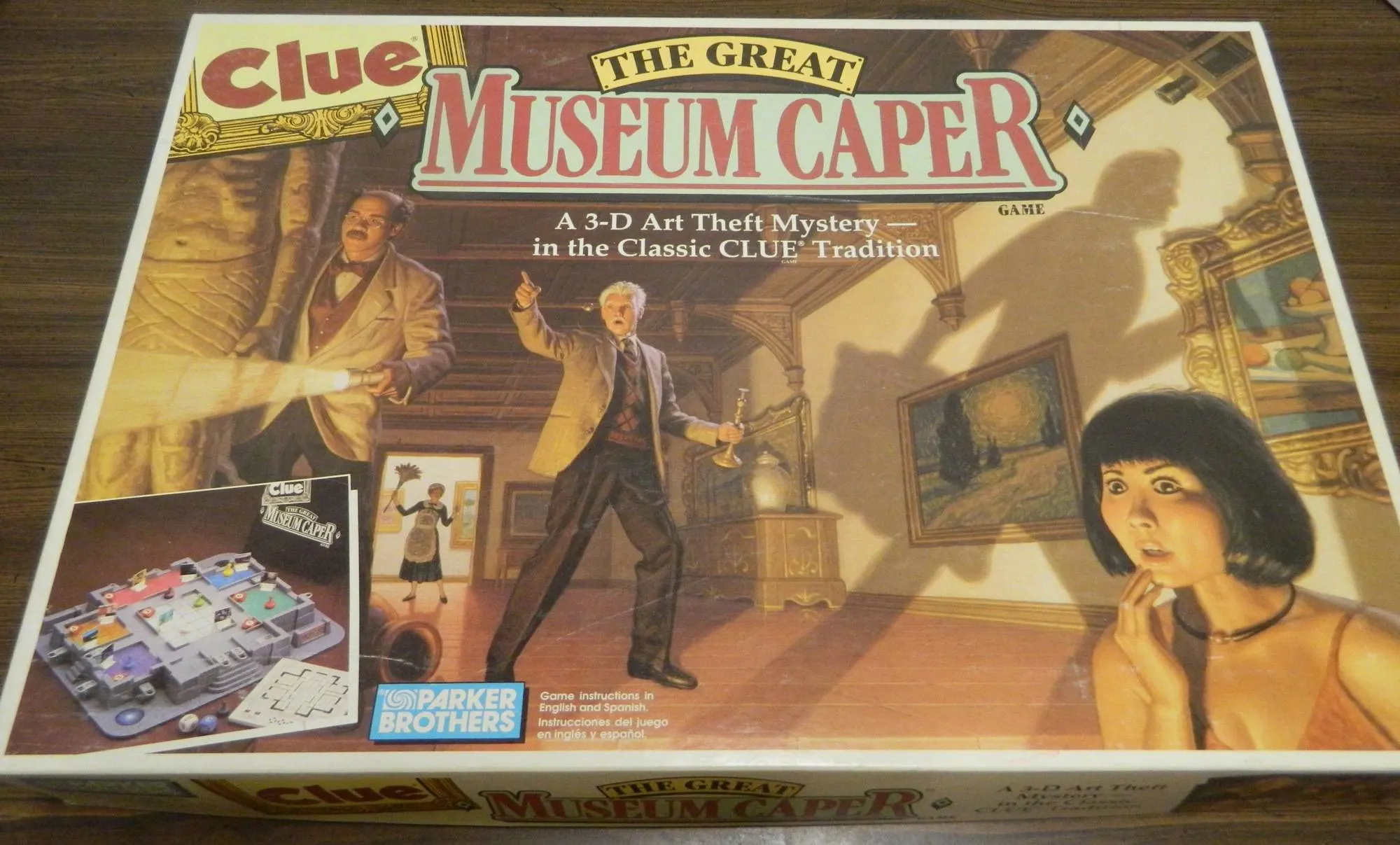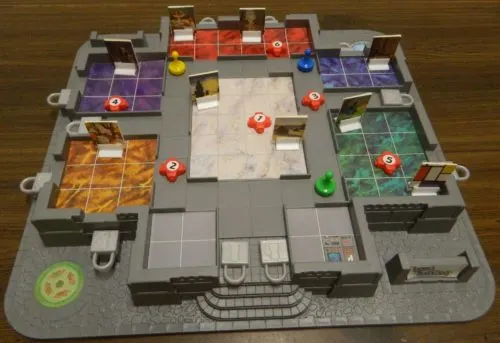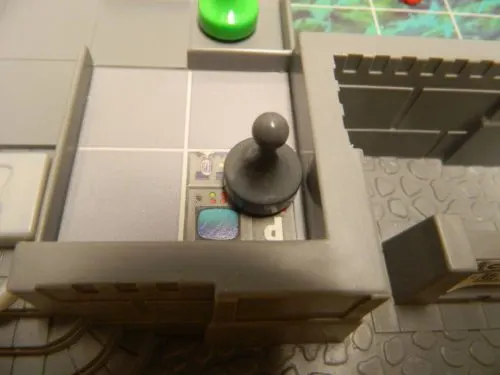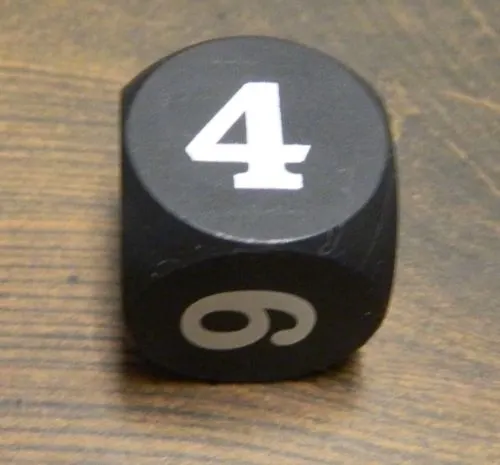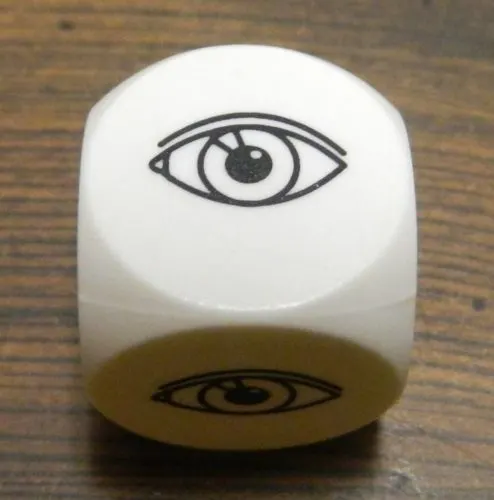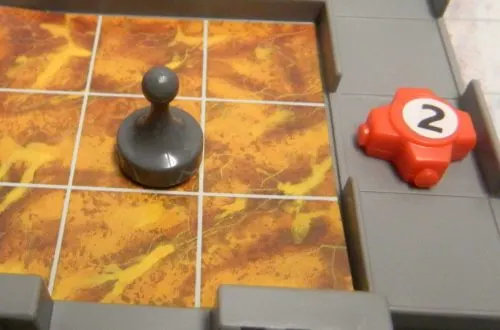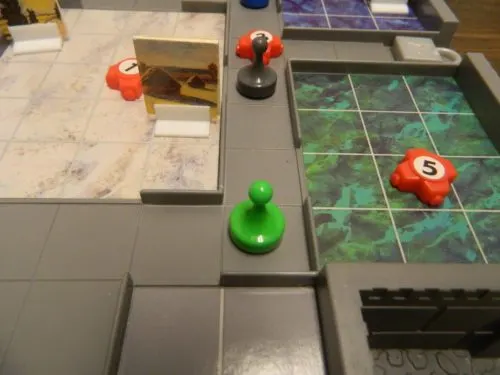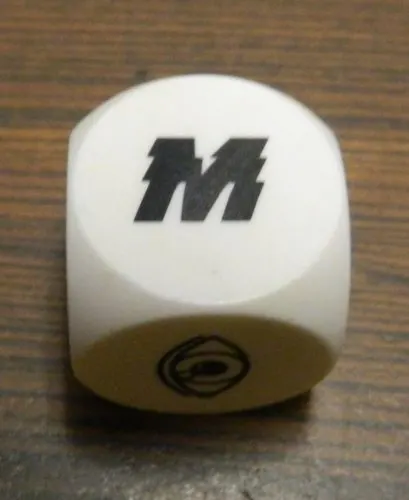First created in 1949, the original Clue is probably the most well known deduction board game of all time. Due to it’s popularity the game has had quite a few different spinoffs created over the years. One of Clue’s most popular spinoff games is today’s game Clue The Great Museum Caper. In this game you no longer are trying to find a murderer but instead are trying to capture a thief in the process of robbing a museum. The game is a cooperative game where one player plays as the thief and the rest of the players try to capture them. Clue The Great Museum Caper succeeds in creating a unique experience that unfortunately is going to be more enjoyable for some players than others.
How to Play Clue The Great Museum Caper
Setup
Players will have to choose whether they are going to play one game or whether they are going to let each player be the thief once. Players also have to choose who will be the thief in the first game. The rest of the players will play as detectives. Setup is broken down by the two groups of players: the detectives and the thief.
All of the character players work together to perform the following setup steps:
- The players can either randomly add one lock to each window and door or the players can choose which lock they want to place on each spot.
- The players will choose the locations for the nine paintings. The players must put at least one painting in every main room. They cannot put a painting in the power room or in one of the corridors. Paintings also can’t be placed in front of a window or a doorway.
- The players can place the cameras on any space that does not contain a painting. The cameras can see any space in a straight line from each side of the camera that isn’t blocked by a wall.
- Finally each player chooses a character pawn and can place it on any space that does not contain a painting.
The thief player then has to do the following:
- Set up the thief shield and place your thief plotting pad behind it. Turn the gameboard so it is easier for the thief to line up the spaces on the board with the spaces on their thief plotting pad.
- Place an “x” on every space on your plotting pad that contains a painting. Mark each camera with a number inside a circle.
- The thief chooses the window or door that they will use to enter the museum and writes an “E” on the space.
Playing the Game
In the game turn order will alternate as follows: thief, first player, thief, second player, etc.
Thief Actions
A thief begins their turn by moving between one and three spaces. They can move in any direction except diagonally. All movement is recorded on the thief’s pad. The player can move to any space and marks the final spot with a dot.
When the thief ends their turn on a painting space they circle the painting to indicate that they have stolen it. On their next turn they will move their playing piece and will then remove the painting from the board to indicate that it was stolen.
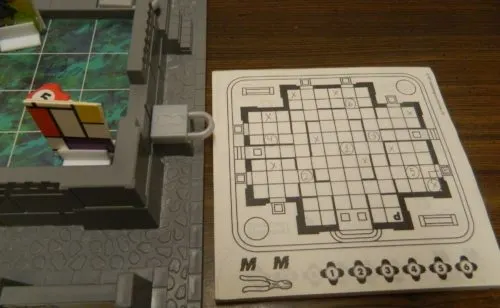
This player has landed on one of the paintings. They have stolen the painting which they will remove after they move on their next turn.
When the thief ends their turn on a video camera they disconnect the camera. Cross off the camera on your pad. The thief doesn’t have to reveal that a camera is disconnected until it is revealed by one of the other player’s actions.
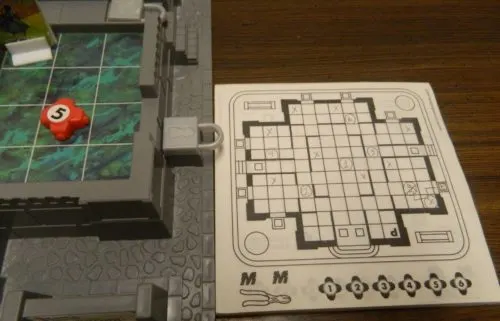
On their previous turn the thief stole the painting from the corner so they remove it from the board after they have moved. Since the thief moves to the camera space, they deactivate the camera.
If the thief ends their turn on the “P” space they can shut off the power. This disables all of the cameras and the motion detectors. The thief does not have to reveal that the power is off until one of the characters tries to use a camera or the motion detector. One of the other players will have to move to the “P” space to turn the power back on.
If at the end of a player’s turn, one of the characters is on the same space as the thief, the thief is captured and the game/round is over.
Detective Actions
On a detective player’s turn they will roll both dice. The number die determines how many spaces they can move their pawn. The other die determines which special action that the player can perform. The player can choose which die they want to use first.
When moving a player follows these rules. The player can move in any direction except diagonally. The player can move up to the number they rolled but they don’t have to move their entire roll. A player can never land on a space that contains a painting.
The special die gives the player one of three different special actions.
Eye: When a player rolls the eye symbol they can take one of two actions.
- Choose a camera. Ask the thief if the chosen camera is still working. If the camera was deactivated, remove the camera from the board. If the power was turned off, the thief has to tell the player this fact. If the camera is working the thief has to tell the player if the chosen camera can see them. A camera can see in a straight line in all four directions but is blocked by walls. If the camera can see the thief they have to tell the player but don’t have to show where the thief is located.
- The player can ask if their pawn can see the thief. A player can see in a straight line in all four directions but not diagonally. If the player can see the thief, the thief has to reveal their location by placing the gray pawn on the gameboard. The thief will show their moves on the gameboard for the rest of the game.
Scan: The player asks the thief if all of the cameras are still working. If one of more of the cameras have been disabled, the thief removes them from the gameboard. If the power is out the thief has to tell the player. The thief then has to reveal if any of the working cameras can see them. If a camera can see them the thief must reveal the numbers of any camera that can see them.
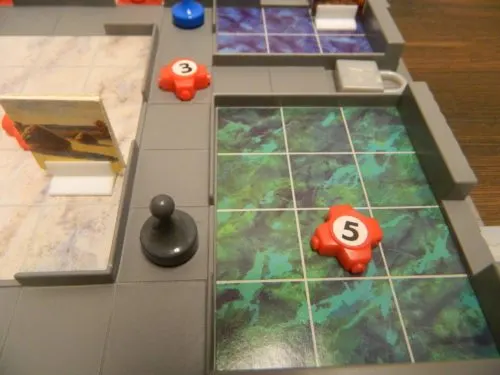
If the thief was on the space indicated by the gray pawn, both cameras three and five could see the thief.
Motion Detectors: The player asks the thief the color of the room that they are currently in. The player can either chose to reveal the color of the room that they are in or they can refuse to answer. If the thief chooses not to answer they must cross off one of the “M’s” on their thief pad. Once both have been crossed off the player has to answer what room they are in for the rest of the game.
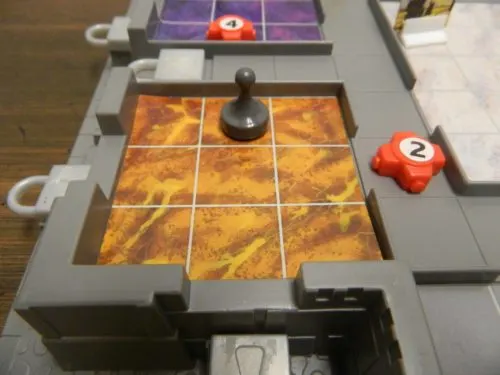
If the thief was in the room indicated by the gray pawn they will have two choices. They can either tell the players that they are in the brown/tan room or they can choose to use one of their two times that they can refuse to answer the question.
The Escape
The thief can choose to escape the museum at any time. If the players are only playing one game though it is recommended that the thief tries to steal at least three paintings. The thief will likely want to try to escape once they have to place their pawn on the gameboard.
In order to escape the thief has to move to a spot in front of one of the windows or doors. They then turn over the lock. If the lock has a “L” on it, the door/window is locked and the thief needs to try another window/door.
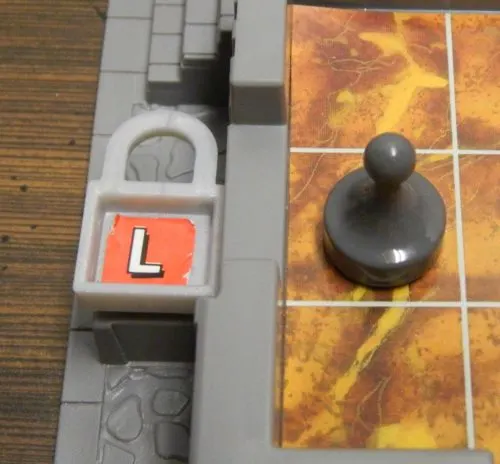
The thief has tried to escape through this window. Since the window is locked the thief will have to try and escape through a different exit.
If the lock has an “O” on it, the thief has escaped and has won the game/round.
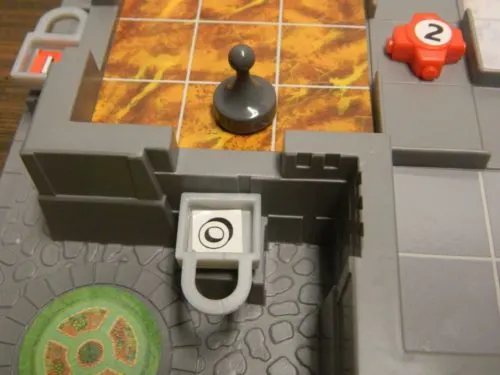
The thief tried to escape through this window. Since the lock has an “O” on it, the thief has escaped from the museum.
If one of the players land on the space that the thief is on, they have captured the thief and the characters win the round/game.
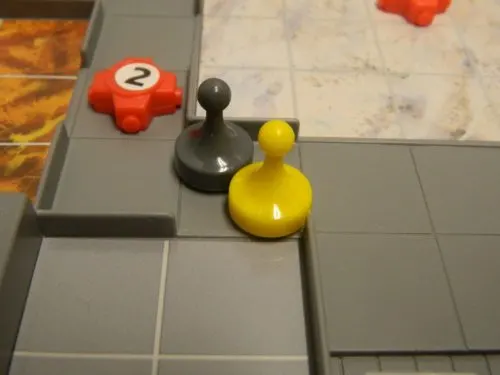
The yellow player has landed on the same space as the thief. The yellow player has captured the thief so their team has won the game.
If the players chose to let each player be the thief once, the next player takes their turn as the thief. After all of the players have been the thief once, the player who stole the most paintings wins the game.
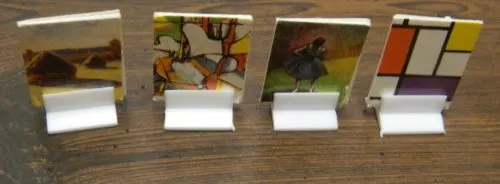
This thief was able to steal four paintings from the museum before they escaped. If none of the players have stolen more or the same number of paintings, this player has won the game.
My Thoughts on Clue The Great Museum Caper
Before getting into the gameplay I want to quickly talk about the game’s theme. Basically I believe the Clue theme was pasted onto Clue The Great Museum Caper in order to try and cash in on the original game to sell more copies of the game. When you break down the game it only shares a couple things in common with Clue. The most obvious similarities are the name and the characters. These are just cosmetic as they have no impact on the actual gameplay. The only other thing that the two games share in common is that both are deduction games where players have to deduce a secret with only limited information. While both games are in the same genre, they both play quite a bit differently.
Clue The Great Museum Caper is an interesting game as it is a semi-cooperative game. All but one of the players have to work together in order to stop the other player. I have always been a big fan of cooperative games as there is something compelling about playing a game with the other players trying to win together. While most cooperative games have the players playing against the game itself, there are some games like Clue The Great Museum Caper where all of the players are playing against one of the other players.
If you have never played Clue The Great Museum Caper before it still may seem familiar as it actually shares a lot in common with a couple other board games. While not exactly the same, Scotland Yard and Fury of Dracula (1987) actually share a lot in common with Clue The Great Museum Caper. All of these games share the mechanic where one player acts alone in secret while the other players try to work together in order to capture them. I haven’t played Scotland Yard in quite a few years but from what I remember the game shares a lot in common with Clue The Great Museum Caper. If you like either of these games I think you will also enjoy Clue The Great Museum Caper as well.
At this point I think it is best to break down the two roles separately as they are quite different from one another.
Let’s start with the thief role. Of the two roles I think it is quite a bit more enjoyable playing as the thief than as one of the detectives. While I actually think there is more strategy on the part of the detectives, I think playing the thief is more enjoyable. The reason why the thief role works so well is that it is fun to know information that the other players are not privy to. It is surprisingly satisfying to get the players to think you are in one part of the museum and then slip right past them into another part of the museum.
As far as the strategy for the thief it mostly comes down to whether you want to play aggressively or passively. A player could be aggressive and take a bunch of paintings quickly which allows them the opportunity to escape the museum quicker. By being aggressive though you draw a lot more attention to your actions which gives the other players a lot more information that they can use to track down your location. By playing aggressively you can decrease the amount of time that the players have to catch you but you make it quite a bit easier for the players to find you on any given turn.
On the other hand you could play more passively. While it might not be as exciting, playing passively severely reduces the amount of information that the other players receive. Instead of going after the paintings right away a player could instead try to disconnect as many of the cameras as possible. This means that the player will spend more time in the museum, increasing the odds that one of the players will randomly run into them, but it also limits the amount of information that the other players will receive. If you can deactivate all of the cameras the other players are going to have a hard time getting any meaningful information unless they get lucky and see you with their own pawns. To make it even harder for the players to pinpoint their position a passive player might choose to spend some turns trying to hide their location after stealing a painting rather than just moving right to the next painting.
Lets now move onto the detective role. Of the two roles I would say that the detective role relies a lot more on deduction. While you will have several players working together, they are never going to have all of the information they need to know the exact location of the thief. These players need to work together using the information gathered through stolen paintings and their special actions to narrow down where the thief could be. Players likely are going to want to spread out so they can cover as much of the museum as possible which lets them see more areas and makes it easier to catch the thief when they are spotted.
While you could use deduction to get a general idea of where the thief could be, the detectives still have to rely on luck to help them out. The area where luck comes into play the most is with the special actions. The two best special actions are probably the scan and motion detectors. The scan ability is powerful since it lets the players see many different areas of the museum. If one or more of the cameras pick up the thief it can give the detectives a lot of information to go off of. The motion detector ability can be really powerful as it will tell the players the exact room that the thief is currently in. The players can then start to narrow down their search to that area of the museum for the next couple turns. As the thief it is a really tough decision determining when to use your two opportunities to refuse to tell the other players what room you are in. If you use them at the right times you can escape from a situation that likely would have lead to your capture.
In most situations it is the worst special ability but the eye ability is key for the detectives to stop the thief. While the detectives might randomly end up landing on the space that the thief is on, you most likely will have to spot the thief with one of the detectives in order to win the game. Once the thief is spotted it is quite a bit easier to capture them. While the thief is going to get to move more often, all of the detectives can work together in order to trap the thief. The players also have the ability to potentially move more spaces which makes it easier for them to catch up. Once the thief’s location is revealed it is generally a good idea for the thief to try and escape as quickly as possible since otherwise they will eventually be captured.
While the detective role has some interesting deduction mechanics, the problem with it comes from the fact that the detectives usually don’t have enough information to go on. This kind of hurts the experience for these players since they are basically guessing for most of the game. While the thief has to work by themself they still have a pretty big advantage in my opinion. Unless the thief is overly aggressive or the detectives get lucky, it is quite easy for the thief to sneak out of the area that all of the players think they are in. If the thief is really passive the detectives will basically have to be lucky in order to catch them. While I haven’t played the game enough to verify this, I would say that the thief is going to win most games/rounds.
With the thief role being quite a bit more enjoyable than the detective role, players will likely prefer to play as the thief rather than one of the detectives. This leads to some good and bad news. The best way to play the game is to have each of the players play the game as the thief once and then players compare the number of paintings stolen to determine the ultimate winner. This is the preferred way of playing the game as it gives all of the players a chance to be the thief and it evens out the fact that the thief role is quite a bit easier.
The problem is that it might take quite a while to play through the game three or four times so all of the players get a chance to be the thief. Each round can have a pretty variable length. A thief could literally be caught in minutes. Most often though each round will probably take at least 20-30 minutes. With four players this means the game will take at least an hour and likely can take over an hour and a half.
If you want a shorter game you will have to play with only one of the players getting a chance to be the thief. This likely will lead to the thief having a good chance of winning the game unless you add some house rules in order to make the game more difficult. The instructions recommend forcing the thief to steal at least three paintings before they can escape. This is a must and it might be a good idea to raise it even higher as otherwise it will be really easy for the thief to escape. I am actually kind of curious how the game would play with more players. The game only recommends four players but has enough components to support more. More players would make it easier to trap the thief but it also would make it easier for the thief to evade individual detectives since it would be longer before they could take another turn.
Finally I would say that the components are nice for the most part. The 3D gameboard is the most noticeable and it looks really nice. The other components are also pretty good. For a Parker Brothers game you really can’t complain about the components. I have to admit that I don’t love that the game requires the use of a scorepad though. While the game gives you plenty of sheets, it is going to be quite a hassle when you run out of sheets. It also becomes kind of hard to track your path on the plotting pad if you end up doing a lot of backtracking. The biggest complaint that I have with the components though is just the size of the box. Clue The Great Museum Caper is far from a small box. While the box was going to have to be pretty big to fit the board, I think the box could have been at least 20-30% smaller than it is. For space conscious people the size of the box might turn them off.
Should You Buy Clue The Great Museum Caper?
Clue The Great Museum Caper might share very little in common with Clue but it is still a very solid game. Instead of Clue the game has a lot more in common with Scotland Yard and Fury of Dracula as one player secretly moves around the board while the other players work together to try and find them. While the thief role is pretty straightforward there is just something satisfying about sneaking right past the other players as they search another part of the museum. While the detective role relies on quite a bit of deduction, there is still quite a bit of reliance on luck. Generally the thief has the advantage in the game because the detectives rarely get enough information to catch them without getting lucky. If time permits I would highly recommend playing the game so each player gets the opportunity to be the thief.
Clue The Great Museum Caper is interesting because it is truly two unique games. The thief role is quite satisfying while the detective role is kind of disappointing due to the lack of information. My final rating kind of reflects the two different roles. The thief role is probably worthy of a 3.5 to a 4 while the detective role is more worthy of a 2.5 to a 3. Since you will be spending more time as a detective I ended up going on the lower end of the range for the final score.
If you are looking for another game that plays just like Clue, you might be disappointed by Clue The Great Museum Caper. If you already own Scotland Yard or Fury of Dracula and Clue The Great Museum Caper sounds too similar in your opinion, it is probably not worth picking up. If the premise sounds intriguing I think you will enjoy the game even though you might want to look into some house rules in order to balance the two roles.
If you would like to purchase Clue The Great Museum Caper you can find it online: Amazon, eBay

